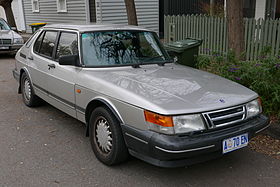Saab 900
| Saab 900 | |
|---|---|
 |
|
| Overview | |
| Manufacturer | Saab (Saab-Scania) |
| Production | 1978–1998 |
| Body and chassis | |
| Class | Compact executive car (D) |
| Layout | FF layout |
| Chronology | |
| Predecessor | Saab 99 |
| Successor | Saab 9-3 |
| Saab 900 "Classic" | |
|---|---|

Saab 900 3-door liftback (first generation)
|
|
| Overview | |
| Manufacturer | Saab Automobile |
| Production | 1978–1993 (1994) |
| Assembly |
Trollhättan, Sweden Arlöv, Sweden Uusikaupunki, Finland (Valmet Automotive) |
| Designer | Björn Envall |
| Body and chassis | |
| Class | Entry-level luxury car/Compact executive car |
| Body style | 2-door convertible 2-door sedan 3-door liftback (hatchback) 4-door sedan 5-door liftback (hatchback) |
| Layout | Longitudinal front-engine, front-wheel drive |
| Powertrain | |
| Engine | |
| Transmission | 4/5-speed manual 3-speed Borg-Warner T-37 automatic |
| Dimensions | |
| Wheelbase | 2,517 mm (99.1 in) |
| Length | 4,685 mm (184.4 in) 4,680 mm (184.3 in) (S & Turbo) |
| Width | 1,690 mm (66.5 in) 1,695 mm (66.7 in) (Turbo SPG Hatch) |
| Height | 1,425 mm (56.1 in) 1,400 mm (55.1 in) (Turbo Convertible & Turbo) 1,405 mm (55.3 in) (Turbo SPG Hatchback) |
| Chronology | |
| Predecessor | Saab 99 |
| Successor | Saab 900 (NG) |
| Saab 900 NG | |
|---|---|
 |
|
| Overview | |
| Manufacturer | Saab Automobile |
| Production | 1994–1998 |
| Assembly |
Trollhättan, Sweden Uusikaupunki, Finland (Convertible) (Valmet Automotive) |
| Designer | Björn Envall, Aina Nilsson Ström (interior), Einar Hareide (1991) |
| Body and chassis | |
| Class | Entry-level luxury car / Compact executive car |
| Body style | 2-door convertible 3-door hatchback 5-door hatchback |
| Layout | Transverse front-engine, front-wheel drive |
| Platform | GM2900 platform |
| Related |
Opel Calibra Opel Vectra Vauxhall Cavalier Saab 9-5 Saturn L-Series |
| Powertrain | |
| Engine | 2.0 L B204 I4 2.3 L B234 I4 2.5 L B258I V6 |
| Transmission | 5-speed F25 manual 5-speed "Sensonic" manual 4-speed automatic |
| Dimensions | |
| Wheelbase | 102.4 in (2,601 mm) |
| Length | 182.6 in (4,638 mm) |
| Width | 67.4 in (1,712 mm) |
| Height | 56.5 in (1,435 mm) 1997-98 Hatchback: 56.6 in (1,438 mm) |
| Chronology | |
| Successor | Saab 9-3 |
The Saab 900 is a compact luxury automobile which was produced by Saab from 1978 until 1998 in two generations. The first generation from 1978 to 1993 is known as the "classic" and the generation from 1994 to 1998 is known as the "new generation" (see below).
The "classic" Saab 900 was based on the Saab 99 chassis, though with a longer front end to meet U.S. frontal crash regulations. The 900 was produced in 2- and 4-door sedan, and 3- and 5-door hatchback configurations and, from 1986, as a cabriolet (convertible) model. There were single- and twin-Zenith carburettor, fuel-injection, and turbocharged engines, including both Full Pressure Turbo (FPT), and, in European models during the early 1990s, Light Pressure Turbos (LPT).
The Saab 900 is a front-engined, front-wheel-drive compact car with a longitudinally mounted, 45-degree slanted, inline four-cylinder engine, double wishbone front suspension and beam-axle rear suspension. It was originally introduced in May 1978, for the 1979 model year.
Like its predecessor the 99, the 900 contained a number of unusual design features that distinguish it from most other cars. First, the engine was installed "backwards", with power delivered from the crank at the front of the car. Second, the transmission, technically a transaxle, bolted directly to the bottom of the engine to form the oil pan (albeit with separate oil lubrication). Thus, power from the crank would be delivered out of the engine at the front, then transferred down and back to the transmission below, via a set of chain-driven primary gears. In similar fashion, Minis also had their gearbox mounted directly below the engine; however, the Mini gearbox and engine shared the same oil, whereas the Saab 900 (and 99) gearboxes contained a separate sump for engine oil.
Refined over several decades of two-digit Saab models, the 900's double wishbone suspension design provided excellent handling and road feel. The rear suspension comprised a typical beam axle design, stabilized with a Panhard rod. However, the attachment points between the axle and chassis made up an unusual configuration that, in essence, consists of two Watt's linkages at either end of the axle: A lower control arm attaches the axle to the bottom of the vehicle, while an upper link attaches at the top but faces towards the rear, unlike a typical 4-link design with both lower and upper links facing forward.
...
Wikipedia
